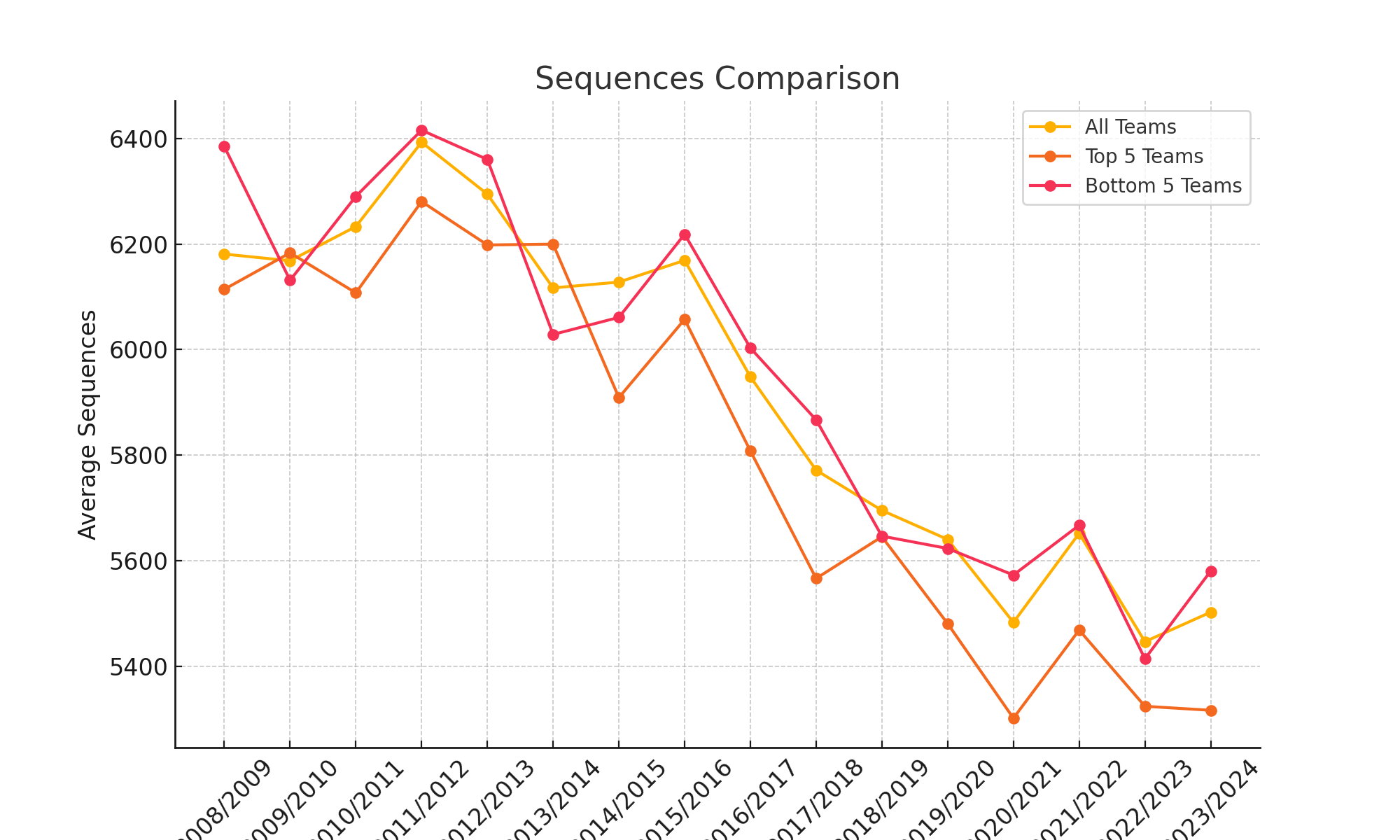
30 Jul Understanding Possession Patterns in LaLiga: Insights from a 15-Season Analysis
Abstract
This study analyzes possession sequences in LaLiga over 15 seasons, focusing on trends in different sequence types based on the number of passes. We compare the performance of the Top 5 and Bottom 5 teams in each season, highlighting significant patterns that correlate with team success or failure. The results indicate a clear pattern where certain possession types, regardless of team diversity and playing style, consistently lead to better or worse outcomes.
Introduction
Possession in football has long been debated as a critical factor in determining a team’s success. However, the complexity of the game means that possession alone is not a definitive indicator of performance. This study aims to explore the evolution of possession sequences in LaLiga over the past 15 seasons, particularly focusing on how different types of sequences correlate with team success. We categorize teams into the Top 5 and Bottom 5 based on their league standing each season and analyze the possession patterns that distinguish these groups.
Methodology
Data was collected from LaLiga matches over 15 seasons, from 2008/2009 to 2022/2023. The key variables analyzed were the number of possession sequences and their categorization based on the number of passes (0 to 2, 3 to 5, 6 to 8, and 9+ passes). We performed a comparative analysis of these variables for the Top 5 and Bottom 5 teams in each season, identified based on their total points. Statistical significance was tested using t-tests to determine if the observed differences in possession sequences between these groups were significant.
Results
Overall Trends
The analysis shows that the total number of possession sequences has decreased over time in LaLiga (see Figure 1). This does not necessarily imply a more direct style of play, as playing style depends more on the type and duration of sequences. We observed that sequences with few passes, particularly 0 to 2 passes, have decreased, while sequences with more than 6 passes have shown stability or even a slight increase (see Figures 2, 3, 4, and 5).

Comparison Between Top 5 and Bottom 5 Teams
The Top 5 teams consistently had higher averages of sequences with 6 to 8 passes and 9+ passes, indicating a preference for more complex and sustained possession phases. In contrast, the Bottom 5 teams showed a higher frequency of sequences with 0 to 2 passes. This could suggest a more direct style of play, but it is important to consider that these teams might not necessarily intend to play directly. The high frequency of short sequences could also result from an inability to maintain possession due to either a lack of player quality or effective defensive pressure from opponents, or a combination of both. These trends are visualized in Figures 1 to 5, which compare the average sequences between the Top 5, Bottom 5, and the overall team averages.
Statistical Significance
T-tests revealed statistically significant differences in possession sequences between the Top 5 and Bottom 5 teams, particularly in the following categories:
- Sequences with 0 to 2 passes: Significantly more frequent among Bottom 5 teams (p < 0.001).
- Sequences with 6 to 8 passes and 9+ passes: Significantly more common in Top 5 teams (p < 0.001).




Analysis of Team Diversity
- Over the 15 seasons, 13 different teams appeared in the Top 5: Barcelona (15), Real Madrid (15), Atlético Madrid (14), Sevilla (8), Valencia (7), Villarreal (7), Real Sociedad (3), Athletic Club (4), Getafe (1), Real Betis (1), Girona (1), Málaga (1), and Mallorca (1).
- On the other hand, the Bottom 5 showed greater diversity with 32 teams: Recreativo Huelva (1), Numancia (1), Getafe (4), Real Betis (2), Osasuna (4), Xerez (1), Real Valladolid (5), Tenerife (1), Málaga (2), Racing Santander (2), Almería (5), Hércules (1), Deportivo La Coruña (5), Mallorca (3), Sporting Gijón (3), Villarreal (1), Granada (6), Rayo Vallecano (4), Real Zaragoza (1), Celta de Vigo (3), Elche (3), Córdoba (1), Eibar (2), Levante (2), Leganés (3), Las Palmas (2), Athletic Club (1), Huesca (2), Girona (1), Espanyol (2), Deportivo Alavés (3), and Cádiz (3).
Teams in Both Categories
Some teams, such as Villarreal, Málaga, and Real Betis, have appeared in both the Top 5 and Bottom 5 categories over these seasons, indicating significant variations in their performance over time.
Discussion
The data suggests a strong correlation between the type of possession sequences and team success. Teams that manage to maintain possession through longer sequences with more passes tend to perform better, reflecting a more controlled and strategic approach to the game. In contrast, teams with a higher frequency of short sequences might not always intend to play directly; instead, they could be constrained by factors such as player quality or the defensive tactics of their opponents, which force them into less controlled possession phases.
The consistency of these trends across diverse teams and over 15 seasons suggests that playing style, characterized by sustained possession, is a key factor in achieving success in LaLiga. This finding challenges the notion that different tactical approaches can equally lead to success, pointing instead towards a «possession-centric» paradigm.
Conclusion
This study underscores the importance of possession strategies in football success. The clear differences between the Top 5 and Bottom 5 teams in terms of possession sequences provide valuable insights for coaches and analysts. Focusing on developing and maintaining longer possession sequences could be a critical factor for teams aiming to improve their standings in LaLiga. Future research should explore the causal mechanisms behind these trends and consider other leagues for broader understanding.


